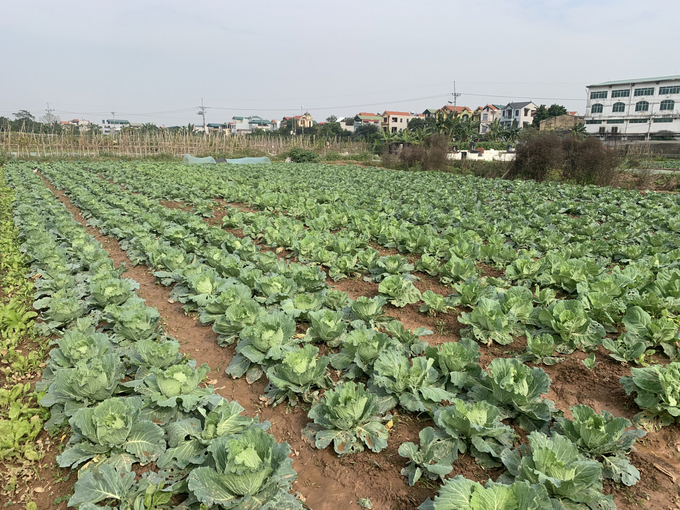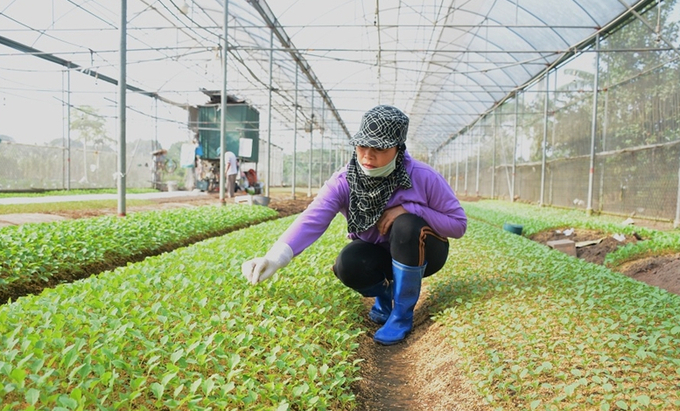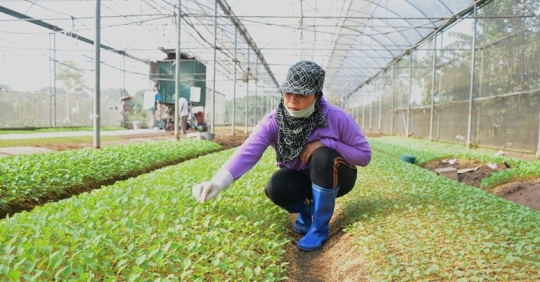
The Dang Xa cooperative has 120 ha of certified safe vegetables and 37 ha of certified VietGAP. Photo: QL
Located next to the Duong River, the Agricultural Service Cooperative of Dang Xa Commune (Gia Lam, Hanoi) has a great advantage in cultivating leafy greens thanks to its fertile alluvium. Although the cooperative’s products always ensure quality and safety, the Dang Xa cooperative faced difficulties in product production before 2012 when it could not secure purchase agreements with companies and supermarkets.
Mr. Nguyen Van Manh, deputy director of Dang Xa cooperative, explained this issue and said that the cooperative was established in the period from 1996 to 2000, so its operational efficiency is low and the cooperative officials have not fully understood the legal documents Law there are delays in the registration of tax identification numbers. Therefore, companies cannot conduct financial and tax transactions with cooperatives, but must pay directly to each farmer’s household.
To overcome the above difficulties, expand acreage and establish production links with companies, Dang Xa Municipality has established cooperatives and production cooperation groups to act as a bridge between cooperatives, farmers and companies such as Tuy Anh Cooperative and Gia Lam Supply and Demand Connection Cooperative, etc., while the Dang Xa Cooperative maintains production management functions, introduces and connects with purchasing units.
Thanks to this, Dang Xa Cooperative’s clean products have been present in many large supermarket systems such as Big C, WinMart, as well as community kitchens and large wholesale markets in many northern provinces and cities. Covering a total area of about 135 ha of all kinds of vegetable and tuber waste crops, Dang Xa Cooperative supplies the market with 50-100 tons of clean vegetables and tubers per day, the main products are: cabbage, tomato, beans, etc. Pumpkin, cabbage…
At present, the cooperative aims to build the Dang Xa brand, produce safe vegetables according to the model of 3 houses: Farmer – Scientist – Entrepreneur, to contribute to building the image of farmers who grow safe vegetables and the trust of build consumers.

The 3-house linkage model brings high economic efficiency to the Dang Xa Cooperative. Photo: QL
To achieve this goal, the Cooperative has built a model of Community Monitoring System for Quality Assurance (PGS), including structure identification, mechanism development, certification, non-compliance management and traceability. Cooperatives established 15 groups, each group has oversight of producers, cooperatives, purchasing units and state administrations.
Each month, the cooperative draws up a plan and assigns tasks to the groups. The groups themselves decide on the quantity and products, based on the supply capacity of the respective household. The groups were trained, kept a vegetable diary and checked the products. In addition, all members of the Dang Xa cooperative have been trained in integrated pest control and the use of pesticides.
Mr. Nguyen Van Manh shared that since the application of the PGS standard in vegetable cultivation, both sides have achieved both quality and yield goals in safe vegetable cultivation thanks to the cooperation between farmers and entrepreneurs.
“This also creates a cultural habit of consumption that helps consumers have confidence in the quality of safe vegetables and safety for everyday use. This is a great achievement in connecting and creating a chain of safe vegetable production in Hanoi,” Manh said.
Ms. Nguyen Thi Chung, member of Dang Xa cooperative, which currently has 5 Sao all kinds of leafy vegetables such as cabbage, kale, spring onion, etc. Chung’s family has benefited, the profit is about VND 30-40 million/sao/year.
“Thanks to the transition to the model of safe vegetable cultivation using organic fertilizers, no pesticides, and the application of PGS standards, the family’s consumption of leafy greens is much cheaper, thanks to the guarantee standards of food safety and hygiene,” Ms. Chung added.
In order to meet the standards of safe vegetable cultivation, Ms. Chung also regularly updates her cultivation and pest control knowledge from Gia Lam District Plantation and Crop Protection Station.

